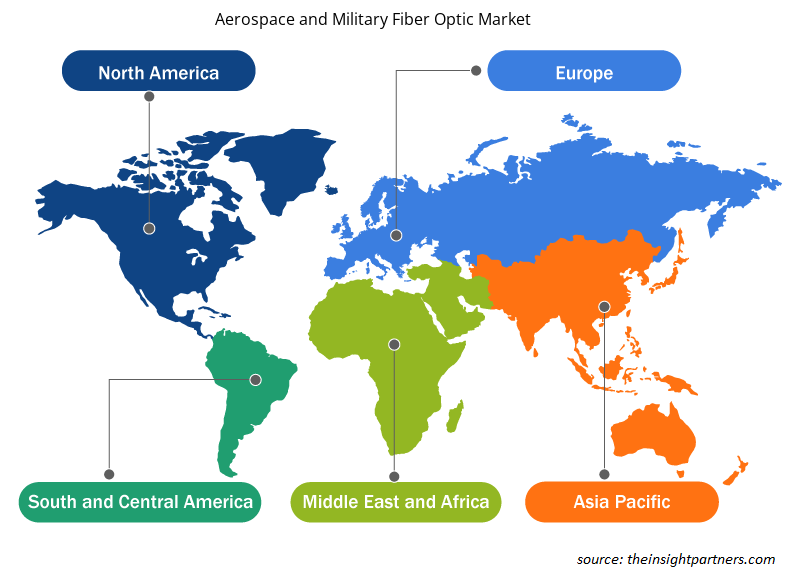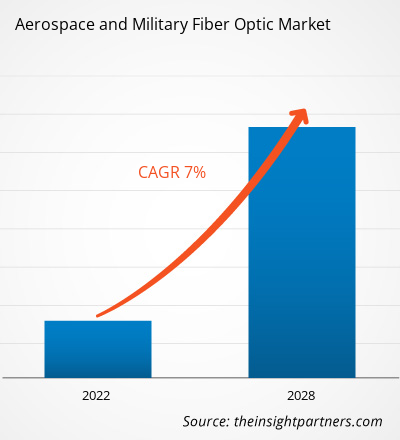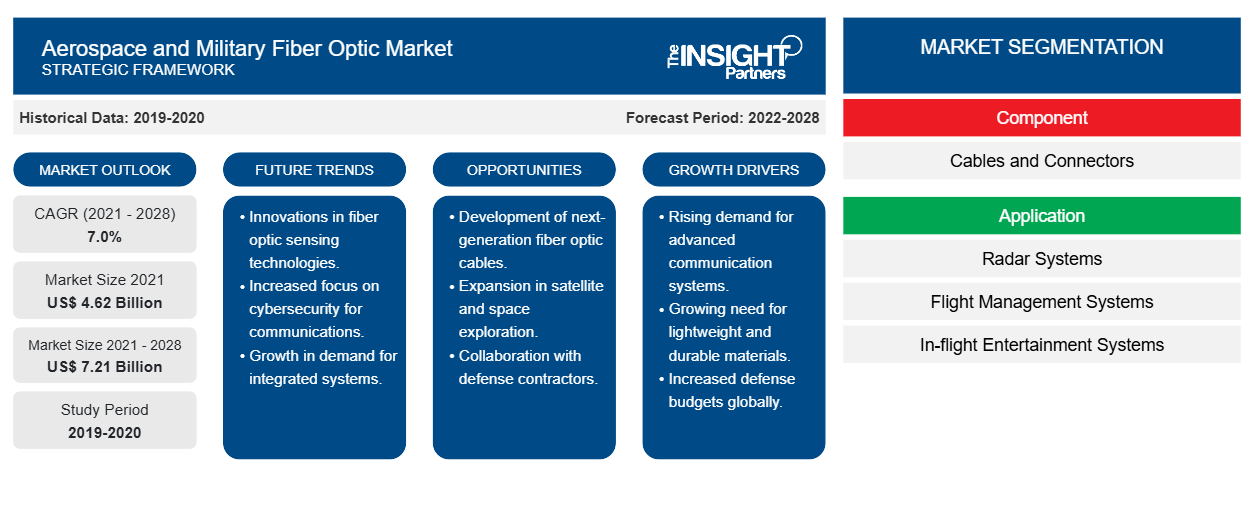Si prevede che il mercato della fibra ottica aerospaziale e militare raggiungerà i 7.208,36 milioni di dollari entro il 2028, rispetto ai 4.623,81 milioni di dollari del 2021; si prevede una crescita a un CAGR del 7,0% dal 2022 al 2028.
Un cavo in fibra ottica è un fascio di fili ottici con un diametro (filo singolo) maggiore del diametro di un capello umano; ciascuno di questi fili può trasferire dati codificati come onde luminose. La fibra ottica sta sostituendo l'ottica metallica nelle applicazioni aerospaziali e militari grazie alla sua capacità di resistere ad ambienti difficili. L'uso della fibra ottica nella trasmissione dati consente la trasmissione su lunghe distanze, conferisce immunità alle interferenze elettromagnetiche e supporta un'elevata larghezza di banda con elevate velocità e nessuna perdita di dati. I cavi in fibra ottica sono più leggeri e più piccoli dei cavi metallici e più sicuri per le attività vulnerabili. La domanda di fibra ottica nelle comunicazioni aerospaziali e militari è in aumento a causa di efficienti sistemi di gestione del volo, sistemi di comunicazione, sistemi di intrattenimento in volo, avionica per guerra elettronica, interni di cabina e sistemi radar. La crescente domanda di maggiore larghezza di banda, affidabilità e cellule in aeromobili nuovi e aggiornati stimola la crescita del mercato della fibra ottica aerospaziale e militare.
Secondo un recente studio dell'Organizzazione Internazionale per l'Aviazione Civile (ICAO), si prevede che il traffico passeggeri e merci raddoppierà entro il 2035. Il numero di viaggiatori aerei sta aumentando con l'aumento del reddito disponibile della classe media e l'aumento delle operazioni e della popolarità delle compagnie aeree low-cost. Con l'aumento del numero di passeggeri nei principali paesi come Canada, Stati Uniti, Brasile, Indonesia, Filippine, Cina, Arabia Saudita e India, aumenta anche il numero di consegne di aeromobili commerciali. Un aumento delle consegne di aeromobili commerciali con soluzioni integrate avanzate si aggiunge alla domanda di fibra ottica. Secondo il Bureau of Transportation, le compagnie aeree statunitensi hanno segnalato un aumento significativo del numero di passeggeri da ottobre 2020. Un conseguente aumento del passaggio verso l'avanguardia dei sistemi di comunicazione, radar e navigazione per garantire operazioni aeree semplificate stimola ulteriormente la crescita del mercato della fibra ottica aerospaziale e militare
Personalizza questo report in base alle tue esigenze
Riceverai la personalizzazione gratuita di qualsiasi report, comprese parti di questo report, o analisi a livello nazionale, pacchetto dati Excel, oltre a usufruire di grandi offerte e sconti per start-up e università
- Scopri le principali tendenze di mercato in questo rapporto.Questo campione GRATUITO includerà analisi di dati che spaziano dalle tendenze di mercato alle stime e alle previsioni.
Impatto della pandemia di COVID-19 sulle dimensioni del mercato della fibra ottica aerospaziale e militare
La pandemia di COVID-19 ha ostacolato in modo sostanziale le industrie in Europa. La pandemia di COVID-19 ha innescato risposte politiche senza precedenti nei paesi europei che hanno colpito la crescita economica della regione durante il Q2 e il Q3 dell'epidemia. Ciò ha ulteriormente causato interruzioni in più catene di fornitura in vari settori europei a causa dei lockdown imposti dai membri dell'Unione Europea (UE) per frenare l'epidemia.lockdowns imposed by the European Union (EU) members to curb the outbreak.
L'esercito europeo è stato duramente colpito dall'elevato numero di casi di COVID-19 nella regione dal 2020 al 2021. La pandemia di COVID-19 ha anche innescato un calo della domanda di equipaggiamento militare, con conseguente riduzione della produzione e impatto negativo sulla crescita delle infrastrutture militari europee. Tuttavia, contrariamente ai fattori sopra menzionati, gli operatori del mercato europeo della fibra ottica aerospaziale e militare sono riusciti ad acquisire contratti aerospaziali e in fibra ottica da varie forze militari in tutto il mondo. Ciò ha consentito agli operatori del mercato di generare ricavi e contribuire alla crescita del mercato. Pertanto, i ricavi generati nel 2020 sono stati relativamente inferiori rispetto al 2019.
Approfondimenti di mercato – Mercato della fibra ottica aerospaziale e militare
La crescente domanda di nuovi e affidabili cavi e connettori in fibra ottica per sistemi di comunicazione è anche uno dei principali fattori che guidano il mercato della fibra ottica aerospaziale e militare in questa regione. Secondo Airbus Global Market Forecast, la flotta di aeromobili commerciali era di 22.950 unità all'inizio del 2020 e si prevede che salirà a 46.720 unità entro il 2040. I produttori di aeromobili commerciali e per l'aviazione generale si concentrano su soluzioni tecnologicamente avanzate, come intrattenimento in volo (IFE) avanzato e interni di cabina, avionica robusta e sistemi radar avanzati . L'integrazione di tali componenti con flotte moderne è un fattore primario che catalizza l'approvvigionamento di fibra ottica, come cavi e connettori. Inoltre, l'aggiornamento delle flotte di aeromobili commerciali e per l'aviazione generale esistenti svolge un ruolo cruciale nel guidare la crescita del mercato della fibra ottica aerospaziale e militare. I modelli di business incentrati sul cliente in continua espansione tra i proprietari di aeromobili commerciali e di aviazione generale stanno dando un notevole impulso al settore IFE, che sta stimolando l'installazione di cavi e connettori in fibra ottica, catalizzando così la crescita del mercato aerospaziale e militare della fibra ottica.IFE) and cabin interiors, robust avionics, and enhanced customer-centric business models among commercial and general aviation aircraft owners are substantially boosting the IFE domain, which is propelling the installation of fiber optic cables and connectors, thereby, catalyzing the aerospace and military fiber optic market growth.
Approfondimenti basati sulle applicazioni
Il mercato della fibra ottica aerospaziale e militare, in base all'applicazione, è segmentato in sistemi radar, sistemi di gestione del volo , sistemi di intrattenimento in volo, sistemi di comunicazione, guerra elettronica, interni di cabina e avionica. Si prevede che il segmento dei sistemi di comunicazione registrerà il CAGR più elevato durante il periodo di previsione. I sistemi di comunicazione richiedono un elevato grado di equipaggiamento tattico per connettersi alla griglia informativa globale di dati e informazioni condivisi. Le reti di cavi in fibra ottica vengono utilizzate per inviare dati di intelligence, sorveglianza e ricognizione tramite vari sistemi di comunicazione. Satelliti, collegamenti terrestri interconnessi e sistemi di comunicazione sono componenti importanti delle reti di comunicazione perché consentono la trasmissione sicura dei dati attraverso collegamenti dati sicuri. Queste linee dati utilizzano protocolli di comunicazione compatibili per comunicare informazioni tra alleati in modo sicuro. Pertanto, tutti questi fattori contribuiscono collettivamente alla crescita dei sistemi di comunicazione nel mercato della fibra ottica aerospaziale e militare.
L'analisi del mercato della fibra ottica aerospaziale e militare è segmentata in base a componente, applicazione, utente finale e area geografica. In base al componente, la dimensione del mercato della fibra ottica aerospaziale e militare è segmentata in cavi e connettori. In base all'applicazione, il mercato della fibra ottica aerospaziale e militare è segmentato in sistemi radar, sistemi di gestione del volo, sistemi di intrattenimento in volo, sistemi di comunicazione, guerra elettronica, interni di cabina e avionica. In base all'utente finale, il mercato è diviso in commerciale e militare. In base all'area geografica, il mercato della fibra ottica aerospaziale e militare è principalmente segregato in Nord America, Europa, Asia Pacifico (APAC), Medio Oriente e Africa (MEA) e Sud e Centro America. Carlisle Interconnect Technologies (Stati Uniti), TE Connectivity (Stati Uniti/Svizzera), AFL (Stati Uniti), WL Gore and Associates, Inc. (Stati Uniti), Amphenol FSI (Stati Uniti), Prysmian Group (Italia), Raytheon Technologies Corporation (Stati Uniti), Prysmian SpA (Italia), Nexans SA (Francia), Radiall (Francia) e Glenair, Inc. (Stati Uniti) sono tra i principali attori del mercato della fibra ottica nel settore aerospaziale e militare.
Approfondimenti regionali sul mercato della fibra ottica aerospaziale e militare
Le tendenze e i fattori regionali che influenzano il mercato della fibra ottica aerospaziale e militare durante il periodo di previsione sono stati ampiamente spiegati dagli analisti di Insight Partners. Questa sezione discute anche i segmenti e la geografia del mercato della fibra ottica aerospaziale e militare in Nord America, Europa, Asia Pacifico, Medio Oriente e Africa e America meridionale e centrale.

- Ottieni i dati specifici regionali per il mercato della fibra ottica aerospaziale e militare
Ambito del rapporto sul mercato della fibra ottica aerospaziale e militare
| Attributo del report | Dettagli |
|---|---|
| Dimensioni del mercato nel 2021 | 4,62 miliardi di dollari USA |
| Dimensioni del mercato entro il 2028 | 7,21 miliardi di dollari USA |
| CAGR globale (2021 - 2028) | 7,0% |
| Dati storici | 2019-2020 |
| Periodo di previsione | 2022-2028 |
| Segmenti coperti | Per componente
|
| Regioni e Paesi coperti | America del Nord
|
| Leader di mercato e profili aziendali chiave |
|
Densità degli attori del mercato: comprendere il suo impatto sulle dinamiche aziendali
Il mercato della fibra ottica aerospaziale e militare sta crescendo rapidamente, spinto dalla crescente domanda degli utenti finali dovuta a fattori quali l'evoluzione delle preferenze dei consumatori, i progressi tecnologici e una maggiore consapevolezza dei vantaggi del prodotto. Con l'aumento della domanda, le aziende stanno ampliando le loro offerte, innovando per soddisfare le esigenze dei consumatori e capitalizzando sulle tendenze emergenti, il che alimenta ulteriormente la crescita del mercato.
La densità degli operatori di mercato si riferisce alla distribuzione di aziende o società che operano in un particolare mercato o settore. Indica quanti concorrenti (operatori di mercato) sono presenti in un dato spazio di mercato in relazione alle sue dimensioni o al valore di mercato totale.
Le principali aziende che operano nel mercato della fibra ottica aerospaziale e militare sono:
- Tecnologie di interconnessione Carlisle
- Società per azioni Amphenol
- Società di tecnologie
- Gruppo Prysmian
- Società anonima ITT Inc.
Disclaimer : le aziende elencate sopra non sono classificate secondo un ordine particolare.

- Ottieni una panoramica dei principali attori del mercato della fibra ottica aerospaziale e militare
Gli operatori che operano nel mercato della fibra ottica aerospaziale e militare si concentrano principalmente sullo sviluppo di prodotti avanzati ed efficienti.
- Nel 2021, Amphenol Corporation ha acquisito Halo Technology Limited per circa 715 milioni di dollari USA. Halo ha sede a Tustin, California, con attività in Nord America ed Europa, ed è un fornitore leader di componenti di interconnessione in fibra ottica attivi e passivi per i mercati delle infrastrutture di comunicazione, e ha registrato vendite per circa 250 milioni di dollari USA nel 2021.
- Nel 2021, Amphenol Corporation ha acquisito Positronic per fornire ai clienti un'ampia gamma di prodotti e supporto tecnico alla progettazione per le loro soluzioni di interconnessione.
- Analisi storica (2 anni), anno base, previsione (7 anni) con CAGR
- Analisi PEST e SWOT
- Valore/volume delle dimensioni del mercato - Globale, Regionale, Nazionale
- Industria e panorama competitivo
- Set di dati Excel
Report recenti
Rapporti correlati
Testimonianze
Motivo dell'acquisto
- Processo decisionale informato
- Comprensione delle dinamiche di mercato
- Analisi competitiva
- Analisi dei clienti
- Previsioni di mercato
- Mitigazione del rischio
- Pianificazione strategica
- Giustificazione degli investimenti
- Identificazione dei mercati emergenti
- Miglioramento delle strategie di marketing
- Aumento dell'efficienza operativa
- Allineamento alle tendenze normative





















 Ottieni un campione gratuito per - Mercato della fibra ottica aerospaziale e militare
Ottieni un campione gratuito per - Mercato della fibra ottica aerospaziale e militare